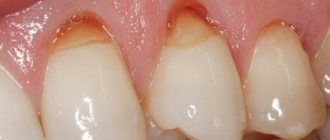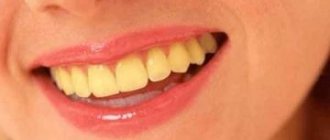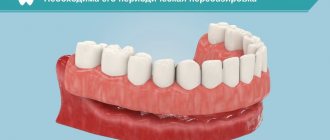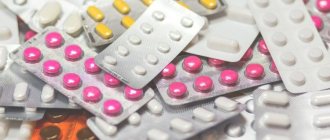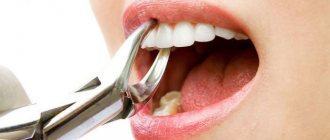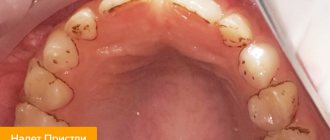One of the most common causes of oral diseases is dental plaque, or rather the bacteria that contribute to its appearance. If soft plaque is not removed in time, it mineralizes, that is, it hardens and turns into tartar. Tartar is the main cause of inflammation and bleeding of the gums, bad breath and the development of periodontitis. To maintain healthy teeth and gums, you can use plaque indicators.
Plaque indicators are special products that paint dental plaque in bright colors, because in the initial stages of plaque formation it is impossible to notice the naked eye.
How do indicators “color” teeth?
All products that are produced abroad today are a mixture of two dyes:
- brilliant blue - used for coloring confectionery products;
- violet - included in lipsticks in rich red shades.
Both dyes are recognized as absolutely safe, as they are added to food all over the world. Therefore, plaque indicators can be used by everyone, regardless of age. This is the main advantage of indicators.
What are plaque indicators used for? If such a composition gets on the teeth, the dye interacts with the resulting plaque and clearly reveals it. Moreover, the blue dye “sticks” better to dense old plaque, which cannot be removed without professional cleaning, while purple dye interacts well with fresh plaque. Therefore, when using plaque indicators, teeth may appear either pinkish or bluish-blue in various shade variations. The only side effect of using these products is that your tongue will turn a deep purple color for up to six hours. However, while for adults this is an embarrassing inconvenience, for children it is a fun highlight that they can show off to their friends.
The best manufacturers
Which company is better to choose a product? There is a wide variety of these manufacturers on the dental product market. The demand for the product largely depends on the manufacturer. The most popular well-known brands, according to customer reviews:
- Curaprox. This Swiss manufacturer produces oral care products. All products are developed taking into account new technologies and are popular among the population.
- StomaDent. This Russian manufacturer has been on the goods market since 1989. Produces quality products. In its arsenal it has dental products for various purposes.
- PresiDENT. The Italian manufacturer launched the company in 1999. A wide range of products are produced according to the ISO International Quality System. This process is led by Italian technologists and dentists.
- Modum Wünderdent. The famous Belarusian, together with the German company Weisskoss GmbH, created the products of this brand. Although it is considered a young competitor in the dental market, it is not inferior in quality to its rivals.
- Miradent. The German manufacturer was founded in 1982 and is a subsidiary brand of Hager&Werken. Engaged in the development of highly effective dental products that meet all norms and standards. The products are manufactured by world-class dentists and leading pharmacists.
- Paro. This Swiss manufacturer has been operating in the dental market since 1978. They produce products that prevent gum and tooth disease. The company has developed and tested all its products using the latest technologies.
Types of indicators
There are two types of means for detecting plaque on teeth.
- Pills.
They must be chewed and distributed with the tongue over the surface of the teeth. Plaque is colored in different shades, revealing areas of the teeth that need additional attention. - Solution.
They need to rinse their mouth after brushing or apply it with a brush, then wait a few minutes and evaluate the result of the hygiene procedures. After assessing the result, it is usually enough to re-use the toothbrush and toothpaste. Dyes are easily washed off from teeth along with dangerous plaque residues.
Why do children get Priestley plaque on their teeth?
If you notice dark spots on your child's teeth, contact your dentist to determine the cause. The pediatric dentist will determine whether the dark spots on the child's teeth are a sign of tooth decay or are caused by other reasons. Often brown spots on baby teeth appear due to an excess of pigmented bacteria. This type of plaque is called Priestley's plaque.
Priestley's plaque in children does not pose a threat of caries and is in no way associated with gastric or intestinal problems, for example, dysbiosis. Usually, after changing the bite, Priestley's plaque disappears on its own.
Plaque indicators for children
It will be quite difficult for kids to get used to the indicator in tablet form, so experts recommend starting with the product in liquid form.
A plaque indicator for a child is a good way to form a healthy habit of brushing teeth correctly from an early age. Using the product usually turns into a game: children like to watch how their white teeth change color, and then “fight” bacteria in those areas that the solution highlights brightly.
Adults in this game play the role of attentive observer. It is necessary to monitor the dosage of the product to ensure that the composition does not get on clothing, as it can stain it. After the “battle” with plaque, the liquid does not need to be swallowed. After cleaning, all stained areas of the teeth should return to their usual color.
Removing dark plaque from a child
Priestley's plaque was removed using ultrasound. For children who do not really like brushing their teeth using the Air Flow method, soft plaque is removed with special brushes and pastes. After professional cleaning, teeth are polished, become smooth, and less plaque settles on the enamel.
The enamel was strengthened using Tooth Mousse cream. The active components of Tuss Mousse make teeth enamel stronger, protecting teeth from caries.
There is no longer a single dark stain on your teeth!
Which indicator should you choose?
Manufacturers of the most famous indicators at the moment, in the line of which you can find both liquid products and indicators in tablet form:
- Miradent;
- Curaprox.
The production volume can be different, so it’s easy to choose the one that’s right for you: a package of tablets can contain from 6 to 250 pieces. A bottle of liquid - from 10 to 500 milliliters.
Some manufacturers provide a separate line of products for children, adding flavors to the solution, for example, chewing gum, which kids like.
Is the composition safe?
Most people believe that such products are very dangerous to health, as they contain many chemical compounds. In fact, such tablets are completely safe for the body, they are allowed even for children. There is no need to swallow them, but if a little product gets inside, nothing bad will happen. Some manufacturers add flavorings to tablets. This gives the tablets a pleasant taste and aroma.
Depending on the manufacturer, the composition may vary slightly. Despite this, we can say with confidence that absolutely all indicators are not hazardous to health.
What to pay attention to
- The plaque indicator may contain xylitol or saccharin to give the solution a pleasant taste, although the product may be completely tasteless.
- Preference should be given to indicators with dyes that act only on the surface of the teeth and do not affect the mucous membrane.
- It is best to avoid solutions or tablets containing gluten or erythrosine due to the body's sensitivity to these substances.
One of the important rules of oral hygiene is thorough removal of plaque from the surface of the teeth and tongue. Don't forget that plaque often causes dental diseases. Use the plaque indicator in the form you prefer. It's effective, safe and very simple.
How is plaque formed?
Already 20 minutes after eating, the tooth is covered with a film invisible to the eye - pellicle - this is a kind of matrix for the further formation of plaque and tartar. Microorganisms attach to it and begin to actively multiply, releasing acids that destroy the surface of the enamel and provoke the development of caries.
IMPORTANT!
You should visit your dental hygienist once or twice a year for a professional cleaning. However, to maintain healthy teeth, you need to take care of them at home.
Today, you have a huge range of oral hygiene products in your arsenal: these are various manual and electric toothbrushes, therapeutic and prophylactic pastes, dental floss and brushes, irrigators and all kinds of rinses. All this is aimed at improving the quality of your daily cleaning.
Introduction
Relevance
Every person wants to have a beautiful “Hollywood smile”. It is one of the ways of attraction and communication. Not only a charming smile, but also the health of the body as a whole depends on the condition of your teeth. Poor oral care can have a detrimental effect on human organs. At first glance, it seems to us that we are carrying out all the procedures correctly. But over time, the following diseases appear: caries, stomatitis, periodontitis, etc. It is known that regular and thorough removal of plaque is important in the prevention of caries. However, brushing your teeth does not always guarantee complete removal of plaque. How to find out the degree of cleaning of the oral cavity from bacteria? In our study we will try to find means to indicate dental plaque.
Therefore, the purpose of our research is to find modern means for indicating dental plaque and study dental plaque with their help.
Object of study: modern indicators of dental plaque.
Subject of research: the level of oral hygiene according to the degree of staining of dental plaque using modern indicators.
In accordance with the purpose of the study, a hypothesis was put forward: if plaque has formed in the oral cavity, then the intensity and color of the indicator will depend on the amount and nature (fresh or old) of the plaque.
In accordance with the stated purpose of the study and the hypothesis put forward, the main objectives of the study :
Research objectives:
- Study and analyze various literature on the research topic.
- Study in detail the composition of plaque indicators, advantages and disadvantages.
- Conduct a survey among students at school no.
- Conduct a study of the presence of dental plaque using indicators and assess the level of oral hygiene using hygiene indices.
- Offer recommendations in the form of infographics on the use of plaque indicators.
To solve the assigned problems, the following research methods were used in the work: analysis, synthesis and comparison of various literary sources on the research problem, analysis of data on labels or instructions of drugs, chemical experiment.
Chapter 1. Analysis of literary sources on the research topic
General characteristics of plaque indicators
It is known that regular and thorough removal of dental plaque is important in the prevention of dental caries. However, brushing your teeth does not always guarantee complete removal of plaque. A thin, almost invisible film containing food debris, saliva components and many microorganisms can be located in the interdental space and other secluded places, remaining inaccessible to the brush.
Plaque is difficult to see with the naked eye. But you can feel it if you run your tongue over your teeth. If this accumulated sticky layer is not removed in time, oral diseases and even premature tooth loss may occur. Therefore, to prevent caries, it is necessary to brush your teeth at least once every 2 days so as to completely remove plaque from them.
To ensure that plaque is removed, it must first be visualized. Therefore, since the beginning of the 20th century, specialists working in the field of oral hygiene have been looking for tools that can help easily detect plaque.
To objectively assess the hygienic state of the oral cavity, plaque is now indicated (stained) using special diagnostic dyes (indicators), which are fixed by the organic component of plaque [2].
Many literary sources note [1, 2,4,6] that tools of this kind are created to perform the following functions:
- Demonstrate the presence of particulate matter and plaque;
- Assess the level of dental cleanliness;
- Carry out oral cavity prevention;
- They teach professional hygiene;
- Shows the period of contamination.
The following types of indicators are used for diagnostics:
- Rinse aids;
- Pills;
- Indicator liquid;
- Solutions for application to teeth.
Experts note [1] that drugs in the form of tablets are more convenient to use and compact. Liquid products, due to their consistency, indicate the presence of plaque in places that are difficult to reach with a brush.
The mechanism of action of the indicator is that when applied to dental plaque, the plaque is painted with a bright color, while enamel that is free of plaque, if stained, is not so intense. This procedure allows you to see the places where plaque has remained and spend more time on them when brushing your teeth. Many indicator products have a 2-shade indication: fresh plaque is painted one color, old plaque is painted in another. Which exact shade corresponds to the old and new plaque is indicated in the instructions for a specific material [1, 2, 4, 6].
The use of indicators in the form of tablets and solution differs somewhat. The tablets are chewed and the mixture is spread with the tongue over the surface of the teeth. After which they pause for several tens of seconds, rinse their mouth with water, and contemplate the multi-colored picture, assessing the amount and location of plaque. Then brush your teeth until there are no stained areas left. If they still do not disappear, it means that there is old plaque, or the cleaning was not carried out effectively enough. In the first case, it is recommended to do professional cleaning; in the second case, repeat it more thoroughly. You may have to purchase another, more abrasive paste.
The solution is applied with a brush, tongue dipped in indicator liquid (a few milligrams of the solution are poured onto it) or by simply rinsing the mouth. After this, repeat the same steps as when using tablets: rinse your mouth and brush your teeth until the stained areas are completely removed.
The main precaution when using indicators is to be careful not to accidentally ingest them.
Composition of plaque indicators
Plaque indicators are special dental care products that make plaque visible. A very useful property of indicators is the ability to visualize fresh and old plaque in different color shades.
Our analysis of the information presented on labels and instructions shows that most plaque indicators include main and auxiliary components (see Appendix 1, Table 1).
Depending on the brand and brand, indicators contain various substances that allow them to perform their function with the least discomfort for the user.
The following can be noted as the main components of plaque indicators (see Appendix 1):
- dyes (represented by red and blue food colors, erythrosine, iodeosine);
- substances with antimicrobial effects (potassium sorbate, sodium benzoate);
- preservatives;
- adsorbents.
The main components adsorb and “reveal” the substances contained in plaque in a bright color, signaling where, in what quantity, and what nature (fresh or old) the dental film is preserved.
The function of the auxiliary components of plaque indicators is that they increase the convenience and comfort of using the product. The following are auxiliary means:
- flavorings (essential oils),
- sweeteners (xylitol, saccharin),
- glycerol,
- water.
Based on the analysis of literary sources [1,3,6], we found that in dental practice, 0.75% and 6% solutions of basic fuchsin, 4-5% alcohol solution of erythrosine, erythrosine tablets (according to 6-10 mg), Schiller-Pisarev solution, 2% aqueous solution of methylene blue. In addition, we noticed that erythrosine is an undesirable component in plaque indicators. In Russia, its use as a food additive is prohibited due to the release of iodine, which can negatively affect the thyroid gland.
tablets and solutions are a low-toxicity red dye that stains dental plaque red. The disadvantage of the indicator is the simultaneous staining of the oral mucosa. Available in the form of a 4–5% alcohol solution and tablets.
Sodium fluorescein is a dental plaque dye that does not contain iodine, available under the names “Plak-Lite” (“Blendax”), “Fluorescein” 0.75%. After treatment, dental deposits acquire a yellow glow only when irradiated with a special light source, without staining the gums, so it can be used in patients who are sensitized to iodine.
Fuchsin - 5.6% alcohol solution of basic fuchsin , colors the dental plaque crimson, the drug is used for rinsing.
Schiller-Pisarev solution, Lugolam solution contains KI, crystalline iodine, distilled water. The solutions color the dental plaque yellowish-pink due to the interaction of iodine with polysaccharide glycogen.
Methylene blue - use a 1-2% aqueous solution of methylene blue, colors dental plaque blue-blue.
Composition of dental plaque
To explain the presence of a color palette of plaque indicators, we turned to searching for information on the composition of dental plaque.
Plaque is visible to the naked eye. It is a white soft substance, the basis of which is made up of colonies of various types of microorganisms and food debris enclosed in an organic matrix.
Analysis of literary sources showed [1, 3, 6, 7] that dental plaque is resistant to washing off with saliva and rinsing the mouth. This is explained by the fact that its surface is covered with a mucous semi-permeable mucoid gel. The mucoid film to a certain extent also prevents the neutralizing effect of saliva on plaque bacteria. The latter is insoluble in most reagents and is to some extent a barrier that protects the enamel from chemical and physical reagents.
The chemical composition of dental plaque [7] varies in different parts of the oral cavity and in different people depending on age, diet, hygiene skills, degree of self-cleaning of the oral cavity and other factors.
On average, dental plaque contains 80% water, 20% is dry residue. 40% of the dry residue of dental plaque consists of mineral substances, 60% is organic. Characteristic of dental plaque is its relatively high content of phosphorus, calcium, sodium, potassium, fluorine, iron, and zinc. The fluoride content in dental plaque can be 10-100 times higher than its content in saliva; it ranges from 6-180 mg/kg. Fluoride is included in dental plaque, usually from food, water, saliva, but can also come from tooth enamel when the pH of dental plaque decreases and the processes of enamel demineralization are activated. With age, the fluoride content in dental plaque increases. The total content of minerals in dental plaque is quite high and comparable to their content in dentin and enamel.
Plaque minerals can be organized as hydroxyapatites, fluorapatites, calcium fluoride, and other compounds. It has been shown that the higher the calcium and phosphorus content in dental plaque, the lower its cariogenic potential.
Among the organic components found in dental plaque are proteins, enzymes, carbohydrates (glycogen, glycosaminoglycans) and some amino acids. Acidic metabolic products in dental plaque are contained in higher concentrations than in saliva. Their retention is facilitated by the increased viscosity of unstimulated saliva. Dental plaque at rest contains relatively high levels of acetate compared to lactate.
Many authors generally define dental plaque as an accumulation of bacteria of various types that are incorporated into the matrix. Thus, a two-day dental plaque is almost entirely formed from microorganisms, their concentration per unit volume is very high - 1 mg of dental plaque contains 500 * 106 microbial cells. The number of microorganisms varies from person to person. More than 70% of the colonies are formed by streptococci, 15% by Veillonella and Neisseria, the rest of the flora is diphtheroids, lactobacilli, staphylococci, leptotrichia, fusobacteria, actinomycetes and yeast-like fungi. The flora of dental plaque is inhibited by fluoride contained in drinking water, to which various types of streptococci and bacteria that synthesize iodophilic polysaccharides are especially sensitive. To suppress the growth of bacteria, about 30-40 mg/l of fluoride is needed in drinking water.
The plaque flora is a vigorous ecological system well adapted to its environment. It is able to quickly recover after brushing teeth, exhibiting high metabolic activity, especially in the presence of simple carbohydrates. Depending on the frequency of food intake and the time it remains in the oral cavity, as well as on the effect of inhibitors, the growth rate of bacteria can be extremely low or very high.
1.4 Sociological survey
In order to identify the objects of research, a sociological survey was conducted. Students from 8th to 11th grades took part in the survey. The form consisted of 6 multiple-choice questions (presented below).
- Do you use plaque detergents when brushing your teeth?
- yes 2) no
- What do you think they are used for?
- Demonstrate the presence of particulate matter and plaque;
- Assess the level of dental cleanliness;
- Carry out oral cavity prevention;
- They teach professional hygiene;
- Shows the period of contamination;
- Don't know.
- How often can they be used?
- once a day 2) once a week 3) once a month 4) constantly 5) very rarely 6) once every six months
7) your option
- What would you look for when purchasing this product? Write down the numbers in order of importance.
- price; 2) safety; 3)can be used by children; 4) double color palette (new plaque and old); 5) indicator form (tablets, solution); 6) ease of use.
- Do you think plaque indicators are harmful or beneficial to you?
- harm 2) benefit 3) don’t know 4) both
- Where you can use plaque indicators:
- at home; 2) only in dentistry; 3) both at home and in dentistry; 4) there is no need for these substances.
Analysis of the survey results showed the following that the majority of respondents (80%) do not know and have never used plaque indicators; a small part noted that during a visit to the dentist they treat their teeth with these agents.
One of the areas of use of these funds was noted by the majority of respondents (65%): they are necessary for training in professional hygiene and for determining the presence of plaque.
Students noted that the frequency of using plaque indicators is once a week (20%) or when visiting the dentist, i.e. once every six months (60%).
Some respondents noted that dental indicators are harmless substances and can be used both at home and in dentistry (15%). When choosing such products, students would pay attention first of all to price, ease of use, safety and the ability to use by children; the form - tablets or solutions - was ranked last by the majority of respondents.
Conclusions:
- To objectively assess the hygienic state of the oral cavity, plaque is now indicated (stained) using special diagnostic dyes (indicators), which are fixed by the organic component of plaque (proteins, enzymes, carbohydrates (glycogen, glycosaminoglycans) and some amino acids).
- As diagnostic stains for dental plaque, 0.75% and 6% solutions of basic fuchsin, 4-5% alcohol solution of erythrosine, erythrosine in tablets (6-10 mg each), Schiller-Pisarev solution, 2% aqueous solution of methylene blue are used.
- According to a sociological survey, it can be noted that plaque indicators are most often used in dentistry. Most people do not use them at home, this is due to the fact that little is known about these substances and their purpose.
Experimental study of the presence of dental plaque using indicators
Characteristics of the research object
The purpose of the experimental study: to determine the presence of dental plaque using modern indicators, and from the intensity and color palette to draw a conclusion about the quantity and nature (fresh or old) of dental plaque.
Based on an analysis of the composition of labels and instructions (see Appendix 1) of plaque indicators, as well as taking into account a sociological survey, inexpensive, safe, and easy-to-use samples were selected for the experiment as indicators. In addition, attention was paid to the fact that during use there was no staining of the oral mucosa or the paint disappeared after a short period of time.
The following plaque indicators were selected as objects of study: tablets for indicating plaque Miradent Mira-2-Ton, tablets for indicating plaque “Dynal”.
Experimental technique
It is possible to objectively assess the level of oral hygiene only using hygiene indices [3,5]. The characteristics of some indices are presented in the table (see Appendix 2. See Table 2).
To qualitatively and quantitatively characterize dental plaque, we used the Fedorov-Volodkina Hygiene Effectiveness Index method by changing the coloring solution.
In domestic dentistry, the first clinical method for detecting dental deposits was the method of Yu. A. Fedorov and V. V. Volodkina [3,5], which is based on treating the vestibular surface of the six lower frontal teeth with potassium iodine-iodisto-potassium solution. Based on this method, the authors proposed a hygiene index, widely used in practical dentistry.
The method produces a qualitative and quantitative assessment of dental plaque.
The vestibular surface of the six front teeth of the lower jaw - incisors and canines - is stained with Lugol's solution. Rating on a 5-point system:
5 points - the entire surface of the teeth is stained, 4 points - 3/4 of the tooth surface,
3 points - 1/2 of the tooth surface, 2 points - 1/4 of the tooth surface,
- score - no staining
Then the arithmetic mean is found by dividing the sum of the color of all teeth by their number: Ksr (hygiene index) = Kn (total hygiene index for each of the six teeth) / n (number of teeth).
Good level of hygiene: Ksr=1.0-1.3 b
The indicator is assessed as follows: good index, satisfactory, unsatisfactory, bad, very bad.
Qualitative assessment is carried out according to the intensity of plaque staining: 1 point – no staining;
- score – yellow coloring;
- points – brown coloring.
However, the proposed method has a number of disadvantages:
- determination of the quality and quantity of dental plaque, assessment of the hygiene index was carried out only on one’s own teeth;
- the use of known dyes is impossible when determining the amount of dental plaque on bridges, since these solutions are difficult to wash off from the surface of the dentures.
Experiment results
For the experiment, we asked two volunteers, using the following plaque indicators: Miradent Mira-2-Ton plaque indicator tablets, Dinal, to evaluate the qualitative and quantitative assessment of the presence of plaque.
To do this, we used the Fedorov-Volodkina hygiene efficiency index.
The data is presented in the table.
Conclusions:
- The modern plaque indicators chosen for the experiment performed well.
- The calculated hygiene efficiency index showed unsatisfactory results.
- Modern indicators make it possible to determine the qualitative and quantitative side of dental plaque, and thus pay attention to more thorough oral hygiene to prevent the development of various diseases.
- Recommendations for plaque indicators are presented in the infographic (see Appendix 3).
Conclusion
- It has been established on the basis of information search and analysis of literary sources that for an objective assessment of the hygienic state of the oral cavity, dental plaque is now indicated (stained) using special diagnostic dyes (indicators), which are fixed by the organic component of dental plaque (proteins, enzymes, carbohydrates (glycogen, glycosaminoglycans) and some amino acids) . The problem of finding safe indicators of dental plaque and using them to determine the level of oral hygiene in dentistry is relevant. Many scientists are busy solving this problem, despite close attention to this problem, a radical solution has not yet been found.
- When studying the information provided to consumers about the composition of plaque indicators, we found that 0.75% and 6% solutions of basic fuchsin, 4-5% alcohol solution of erythrosine, erythrosine tablets (6-10 mg each) are used as diagnostic stains for plaque. ), Schiller-Pisarev solution, 2% aqueous solution of methylene blue. In Russia, the use of erythrosine as a dietary supplement is prohibited due to the release of iodine, which can negatively affect the thyroid gland.
- Based on a survey of school students, an analysis of the composition of plaque indicators (a comparative table was compiled) for the experiment, we identified indicators that can be safely used at home - these are tablets for indicating plaque Miradent Mira-2-Ton, “Dinal”. Recommendations were proposed in the form of infographics on the use of these products to monitor the level of oral hygiene.
- To indicate dental plaque, we used the Fedorov-Volodkina hygiene efficiency index and adapted it for Miradent Mira-2-Ton, “Dinal” tablets. The selected modern plaque indicators performed well. The calculated hygiene efficiency index showed unsatisfactory results.
- In a pilot study, we determined that plaque indicators were needed. With their help, at home, by the nature of the color change, you can qualitatively and quantitatively determine plaque (i.e., assess the level of oral hygiene using hygiene indices) and, thus, pay attention to more thorough oral hygiene to prevent the development of various diseases.
Bibliography
- Dyes for identifying dental plaque [Electronic resource] // Dental Journal Update date: 05/03/2015. URL: https://alvistom.com/publ/profilaktika/krasiteli_dlja_vyjavlenija_zubnykh_otlozhenij/1-1-0-10 (access date: 11/04/2020).
- Lyagina A., Chuev V.P., Hygiene lesson plus prevention of dental diseases / Oral hygiene. – 2013.-№3 (80).- P. 6-7.
- Methodological manual for self-training of students of the Faculty of Dentistry on the topic “Index assessment of dental caries and periodontal diseases,” Irkutsk, 2008.-P.23.
- Fundamentals of professional oral hygiene: Guidelines - St. Petersburg: 2004.- P. 56.
- Method for determining the Fedorov-Volodkina hygienic index // E.M. Melnichenko “Prevention of dental diseases”, Minsk, “Higher School”, 1990, pp. 3-17.
- Tsimbalistov A.V., Shtorina G.V. Mikhailova E.S. Professional oral hygiene // St. Petersburg Institute of Dentistry, 2002. - P. 10-20
- Biochemistry of dental plaque. Plaque and caries // Poznayka. https://poznayka.org/s45277t1.html Date added: 2016-07-22 (access date: 11/04/2020).
- Maksimovskaya L.N., Roshchina P.I. Medicines in dentistry. - M. Medicine, 2000. - P. 240 p.
Performed:
Sofia Mikhailovna Kantemirova, 9th grade students of School No. 619
Supervisor:
Candidate of Pedagogical Sciences, chemistry teacher of the highest category at school No. 619, Anastasia Vladimirovna Novikova

